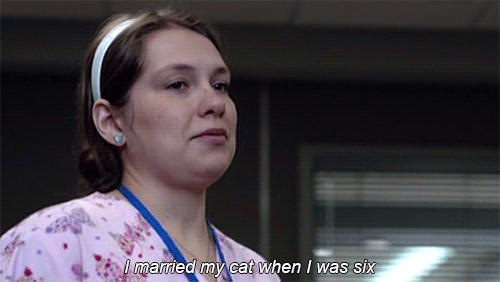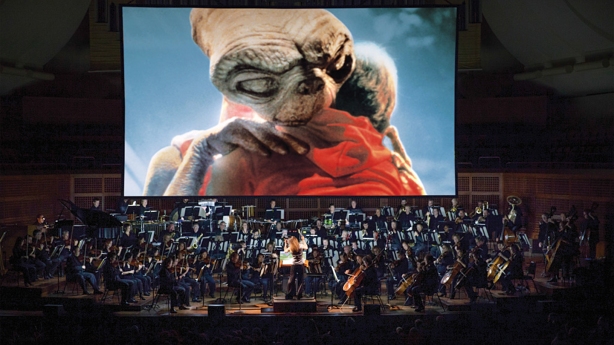
While the monsters and slashers of the 1980s could always pop out and surprise me, they never got under my skin enough for me to say they “scared” me. My fears were not that simple, no… for me, there were two characters that terrorized my dreams as a youngin’, much more than any Krueger-type monster ever could. The first was Miss Carol Burnett’s frightening portrayal of Miss Hannigan in Annie (1982), a performance that still makes my leg shake a bit when I think about it. Tears of terror came to me easily in those days, brought on by the unhinged laughter that erupted from Miss Hannigan as she “paddled” through her bathtub gin and sang about the prohibition of little girls.
As I moved on and backwards into film, it was during my first introduction to Miss Bette Davis that I met the other monster who doled out the goose bumps of my childhood. As the title character in What Ever Happened to Baby Jane?, Miss Davis piles on the clown makeup, layers of lipstick, a beauty mark that resembles a witch’s wart, and terrorizes her wheelchair-bound sister, played by Miss Joan Crawford. Living forever in her head on her childhood stage, Jane (Davis) is a former vaudeville child star now caring for her sister Blanche (Crawford), an actress who found success as an adult before a car accident. Watching Miss Davis gnaw the scenery and spit it at me (and at Miss Crawford) is spectacular — even campy-comical to today’s audience.
However, to a young lad already petrified of evil caregivers thanks to Miss Burnett, Baby Jane could instill fear in me with the raise of an eyebrow. As Jane insults and torments Blanche, she also gives us some of the most quotable lines in movie history . . . well, my movie history. The line “Oh Blanche, y’know we got rats in the cellar,” which is given in reference to possible contents of a dinner tray, still gives me a slight shiver that I’m now able to cover with laughter. So terrified was I of the film that, when it was remade for 1990s television with the Redgrave sisters, I left the room when I saw the commercials for it. (An eerie side note that happens to me all the time — I just flipped over to IMDB.com to check the date of the remake, and on the day I decided to reference the remake on my blog, Lynn Redgrave died.)
Apparently I was not the only terror-stricken member of the family when it came to Baby Jane Hudson. My father always laughs about how he frightened his younger brother by simply mentioning the title of the film in his spookiest voice. If he were a gambling man today, my dad would put money on the chance that my uncle’s face would turn to angered fear, should he relive one of childhood’s many traumas. I guess I see both of their sides . . .

Much of Baby Jane’s greatness lies not only in the performances but also in the incredibly blurry lines between film and reality. For over 50 years now, rumors have flown back and forth about the hatred Miss Davis and Miss Crawford had for each other — despite their truth, kernels of truth, or complete fabrication, I think these stories make the picture even more enjoyable. We’ll never know how it really was, so let’s enjoy what we think we know! In defense of her failed pictures, Jane tells her sister “They were too busy giving a big buildup to that CRAP you were turning out!” Did Miss Davis have to stretch her actress muscles to deliver such a highlighted use of the word “crap,” or was she just getting some of her and Jane’s anger out? What versions of “truth” am I seeing here, and was that the intended version, or just a marvelous accident? Did they fool the whole world into thinking they hated each other more than they did? Those little questions I ask myself during the film fascinate me and are partially why I return to it so often.
To paraphrase something I once read, Joan lit her cigarette like a lady with the fanciest of silver lighters; Bette struck a match on the bottom of her boot like a cowboy . . . what a pair! Ahhh the rumors of fights, bruises, sprained backs, and dirty tricks make Baby Jane all the more sweet for me. The more I learned about the film and about both actresses, the closer attention I paid to every movement, every facial expression, and every slice of truth that I thought I saw slip out. Let’s start with the less “battle scarry” tales . . . I love the story that Bette Davis tells of how the character Jane finally came to her. She says that she wasn’t sure how to play Jane until the moment she saw the wardrobe — understandably, the costume design resulted in the film’s one Oscar win. Miss Davis also claims to have done her own makeup — she was sure that no makeup technician in Hollywood would have the guts to make her as beastly as she could make herself. I’m not sure she saw it as “gutsy” so much as she saw it simply as “her job.” Miss Davis began to define Jane for herself, realizing that Jane was the type of woman who always added more makeup in lieu of washing her face. It worked!

And then there are the tales of Davis versus Crawford, some of which resulted, accidentally of course, in physical injuries. Since Miss Crawford was married to the president of Pepsi Cola at the time, she insisted on product placement in a number of her films. The day after she tried to pull this on the set of Baby Jane, Miss Davis arrived at work with Coke for everyone. When Jane discovers her paralyzed sister on the phone calling for help, she punishes her prisoner by kicking her across the room. As some reports go, Miss Davis actually kicked Miss Crawford one time in the head, causing a gash to appear on Crawford’s near-perfect visage. In retaliation, Crawford lined her costume with weights on the day Davis had to drag her out of bed and across the floor . . . rumors have it that this sprained Davis’s back.
I would never discourage a newcomer to What Ever Happened to Baby Jane? from sitting down and enjoying it for the first time. While it is marvelous for so many reasons, I would like to offer one suggestion — before watching Baby Jane for the first time (or again), see if you can get a hold of a movie or two from the 1930s or 40s with each actress. Knowing that Baby Jane revived both of their careers for a few seconds, I think again, it really adds to this particular movie when you enter into it with a bit of background (even if the background is through the grapevine). Is Baby Jane an enjoyable ride without? Of course! But going into it with the memory of a young, glamorous Joan Crawford or a 30-year-old Bette Davis and her tiny waistline brings out a bit more truth to Jane and Blanche Hudson . . . and their cellar full of rats.

Academy Award (1963) for What Ever Happened to Baby Jane?: Best Costume Design, Black-and-White.
My Oscar Time Machine: I go back and forth whether I would call it a tie between Bette Davis and Miss Anne Bancroft for The Miracle Worker. Miss Bancroft, who won, was not at the awards ceremony that year, and of all people, Joan Crawford graciously offered to accept it for her. So Bette Davis had to watch Joan Crawford, who was not nominated, accept what would have been Miss Davis’s record-breaking third Oscar. Oh sod it; I would have given it to Hepburn.
Add it to your queue.
37.778687
-122.421242











































